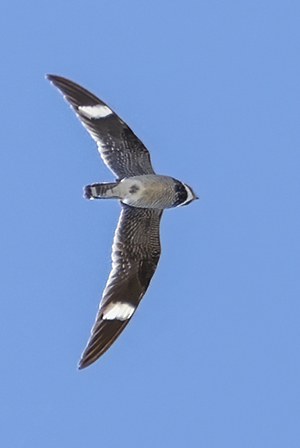Ahh, summertime in Central Oregon--days that seem to stretch on forever, dusk walks around town as the sun dips below the Three Sisters, and the diving flight of common nighthawks. These unusual birds are fascinating on so many fronts, from their nesting behavior to their diving displays to their annual migration. Let’s take a closer look at these birds.
The Common Nighthawk arrives in Central Oregon in late spring and early summer, making it a bird that is often identified with this time of year. They are part of the goatsucker family, named after an incorrect, previously held belief that they flew into barns and sucked the blood of goats. Common nighthawks are around 9.5” long with a wingspan around 24.” They are a mottled brown, gray, white color that helps camouflage them when roosting. In addition, they have a white patch on the outside of both flight wings. They live in towns, recently burned forests, open woodlands, sagebrush flats, and rocky outcroppings.
On warm, summer evenings, you’ll see nighthawks catching their dinner--flying insects. Common nighthawks dine at dusk and dawn using their excellent night vision. If you want to see one, scan the air above a river or brightly lit areas (like streetlights or billboards) during these times. This is where the flying insects are, so this is where the nighthawks are. They are easy to spot with their looping, erratic flight, nearly constant flapping, and sporadic gliding. Their long wingspan and white wing patches help make them even more recognizable.
Beyond this booming sound while diving, males make a sharp “peent” noise, while females tend to remain mostly silent.
Another interesting thing about common nighthawks is that they nest on the open ground; there is no actual nest created. Females generally lay 2 eggs at a time. Both the males and females feed the chicks once they hatch.
Common nighthawks have one of the longest migration routes of any bird in North America. Prevalent through the US, they migrate down to southern South America. Not much is known about their overwintering grounds, however. Although nighthawks are usually solitary, during migration they will form loose groups.
Although it is difficult to get accurate counts of common nighthawks (due to their camouflaged coloring and affinity for dusk and dawn), there has been a 61% decline of the species between 1966-2014. This is believed to have been caused by a decrease in flying insects due to pesticide, as well as habitat loss.
The next time you’re out and about at dusk or dawn, make sure to scan the skies for the common nighthawk, an incredible creature of Central Oregon.
Learn more about birds:


